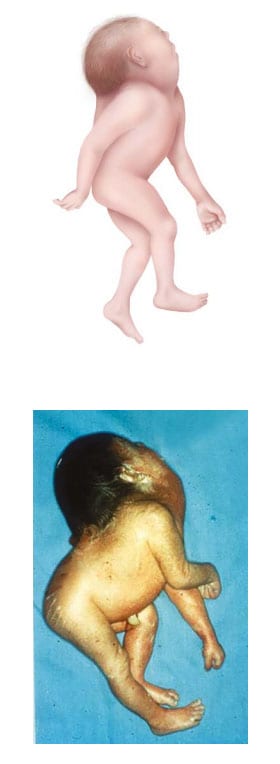Iniencephaly
Iniencephaly is a rare and complex neural tube defect (NTD) involving the occiput and inion, resulting in extreme retroflexion of the head, variably combined with occipital encephalocele or rachischisis of the cervical or thoracic spine.

Photograph source: CDC-Beijing Medical University collaborative project.
- Head – tilted (retroflexed) with upward looking face, a short neck or neck may appear to be missing (due to fusion of the cervical and thoracic vertebrae). Some infants also have an occipital encephalocele.
- Covering – cranium is closed and covered in skin. The internal spine abnormalities result in the skin of the face appearing to be directly connected to the skin of the chest and the skin of the scalp also appearing to be directly connected to the skin of the back.
- Spine – usually closed but might be open at the cervical spine.
Diagnosis
Prenatal. Iniencephaly may be difficult to diagnose by ultrasound and can be confused with other defects involving the brain and spine – anencephaly, encephalocele and craniorachischisis, as well as teratomas, goiter, lymphangioma, and some syndromes. Use programme rules (SOPs) to decide whether to accept or not accept prenatal diagnoses without postnatal confirmation (e.g. in cases of termination of pregnancy or unexamined fetal death).
Postnatal. Careful examination of the fetus or newborn can confirm the diagnosis of iniencephaly and distinguish it from the other anomalies that involve the brain, cranium and spine.
Clinical and epidemiologic notes
- With other unrelated birth defects:
- Micrognathia, cleft lip and palate, cardiovascular disorders, diaphragmatic hernias, and gastrointestinal malformations.
- With certain chromosomal conditions – trisomy 13 and 18, and monosomy X.
- Iniencephaly is more common among female infants.
- Can be confused with craniorachischisis with spinal retroflexion.
Checklist for high-quality reporting
| Iniencephaly – Documentation Checklist |
Describe in detail:
Report whether autopsy (pathology) findings are available and if so, report the results. |